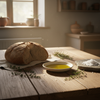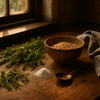How To Mash Potatoes Without A Masher: 5 Easy Methods
You can absolutely mash potatoes without a masher by using common kitchen tools like a fork, wooden spoon, whisk, colander, or even an electric mixer. Each method creates slightly different textures—from rustic and chunky to silky smooth—giving you full control over your mashed potato masterpiece.
The key is choosing the right potato variety, cooking them until properly tender, and using a gentle technique to avoid the dreaded gummy texture.
Key Takeaways
- You can mash potatoes without a masher by using common kitchen tools like a fork, wooden spoon, whisk, colander, or electric mixer.
- Different mashing methods produce varying textures, from rustic and chunky to silky smooth.
- Selecting the right potato variety and cooking them until tender is essential for good mashed potatoes.
- Using a gentle mashing technique helps prevent a gummy texture in the potatoes.
Table of Contents
- Mashing Potatoes Without a Masher: Creative Solutions for Creamy Spuds
- Potato Basics: Choosing Your Spuds Wisely
- The Fork Method: Simple But Effective
- Wooden Spoon and Spatula Techniques
- The Whisk Method: Incorporating Air for Fluffiness
- The Colander Method: Your Secret Weapon for Silky Potatoes
- The Electric Mixer Method: Power Tools for Potatoes
- Advanced Alternatives: Food Processors and Blenders
- Elevating Your Mashed Potatoes: Flavor Variations
- Troubleshooting Common Mashed Potato Problems
- Creative Serving Suggestions: Beyond the Side Dish
- Sustainability Tips: No-Waste Potato Mashing
- Mastering the Art of Masher-Free Mashed Potatoes
Let's be honest—we've all been there. You're elbow-deep in dinner prep, potatoes are boiling, and suddenly you realize: where the heck is that potato masher? Maybe you never owned one. Maybe it's hiding with those missing socks from the dryer. Either way, your spud situation isn't doomed.
At DI ORO, we believe kitchen creativity shouldn't stop because of a missing tool. In fact, some of the most satisfying cooking moments happen when we improvise. So put down the takeout menu and keep those potatoes boiling—your perfect mash is still very much on the menu tonight.
Potato Basics: Choosing Your Spuds Wisely

Before we dive into mashing techniques, let's talk potatoes. Not all spuds are created equal when it comes to mashing, and your choice will significantly impact your final result—masher or no masher.
Starchy vs. Waxy: The Great Potato Divide
Starchy potatoes like Russets and Idaho potatoes break down easily, creating that fluffy, cloud-like texture that makes you want to face-plant right into the bowl. Their high starch content absorbs butter and cream beautifully, making them the traditional choice for classic mashed potatoes.
Yukon Golds offer the best of both worlds—they're medium-starch potatoes with a naturally buttery flavor that mash wonderfully while holding enough structure to avoid becoming gluey. If I had to recommend just one potato for mashing without specialized equipment, Yukon Golds would be my ride-or-die choice.
Waxy potatoes like Red Bliss or new potatoes hold their shape stubbornly, which makes them less ideal for super-smooth mashes but perfect for more rustic, chunky versions. They're also more forgiving if you tend to get a bit enthusiastic with your mashing technique.
Cooking for Success: The Foundation of Great Mashed Potatoes
No matter which tool you'll use for mashing, proper cooking is non-negotiable. Start with evenly cut chunks (about 1-2 inches) to ensure they cook at the same rate. Always begin with cold water—dropping potatoes into already boiling water cooks the outside too quickly while leaving the centers hard.
Salt your cooking water generously. We're talking tablespoon-level generous. This seasons the potatoes from the inside out as they absorb the water. Cook until a fork slides easily through the chunks with zero resistance—undercooked potatoes are the enemy of smooth mashing, regardless of your tool.
Once cooked, drain thoroughly and return them to the hot pot for a minute or two. This crucial step allows excess moisture to evaporate, preventing watery mashed potatoes—a particularly important step when working without a proper masher.
The Fork Method: Simple But Effective
Let's start with the most accessible tool in any kitchen: the humble dinner fork. This method gives you surprisingly delicious results with minimal fuss. For a side-by-side comparison of different potato mashing techniques, Food52 put popular methods to the test—it's a great read for anyone looking to master the art of how to mash potatoes without a masher.
Mastering the Fork Technique
Grab your sturdiest dinner fork—this is not the time for flimsy flatware. Transfer your hot, drained potatoes to a bowl with enough room to work. Hold the fork with the tines facing down and begin pressing into the potatoes, working systematically around the bowl.
The fork method naturally creates a more rustic mash with some texture, which is actually preferable for certain dishes. Think of it as the difference between hand-cut fries and the fast-food version—there's something deliciously authentic about potatoes with a bit of character.
For smoother results, keep at it longer, rotating between pressing and stirring motions. The potatoes will gradually break down further as you work. Adding warm butter early in the process helps lubricate the potatoes, making them easier to mash with your fork.
Pro tip: Warm your milk or cream before adding it—cold dairy products can shock hot potatoes, making them harder to work with and potentially cooling your mash prematurely.
Benefits of Fork Mashing
The fork method gives you incredible control. You can stop when you've reached your preferred texture, whether that's chunky and rustic or relatively smooth. It also minimizes the risk of over-mashing, which can release too much starch and create that gluey texture we all dread.
This technique works especially well with Yukon Golds, which break down more easily than waxy varieties but still maintain enough structure to prevent gumminess. The natural buttery flavor of Yukons also means you can get away with using slightly less added fat while still achieving rich-tasting results.
Wooden Spoon and Spatula Techniques
Your DI ORO wooden spoon or silicone spatula isn't just for stirring—it's a surprisingly effective potato-mashing tool. In fact, America's Test Kitchen has recognized our silicone spatulas for their versatility, and mashing potatoes is definitely within their repertoire. If you're looking for a dependable spatula for these tasks, check out our DI ORO 5-Piece Seamless Spatula Set—a must-have for any home cook improvising how to mash potatoes without a masher.
The Wooden Spoon Method
The technique here is similar to the fork method, but the broader surface area of a wooden spoon makes the work go faster. Use the back of the spoon to press potatoes against the side of your pot or bowl, then stir and repeat.
Wooden spoons provide more leverage than forks, allowing you to apply more pressure with less effort. The flat edge of a wooden spoon is particularly effective at pressing potatoes against the side of the pot.
For even better results, try using the edge of a DI ORO silicone spatula. The flexible edge can conform to the curve of your pot while still providing enough rigidity to break down the potatoes effectively. Plus, the heat-resistant silicone (tested to 600°F) means you can mash directly in the hot cooking pot without worry.
Achieving Creaminess Without a Masher
The secret to creamy mashed potatoes—regardless of your mashing tool—lies in your liquid-to-potato ratio and the order of additions. Start by incorporating butter while the potatoes are still very hot. The fat coats the starch molecules, preventing them from forming the glue-like texture that can happen when liquids are added first.
After the butter has melted in, gradually add warm milk, cream, or a mixture of both, stirring gently between additions. This gradual approach gives you control over the final consistency. Remember that potatoes continue absorbing liquid as they sit, so it's better to err on the slightly too-moist side if you're not serving immediately.
For next-level flavor, try infusing your milk or cream with garlic cloves, herbs like rosemary or thyme, or even a bay leaf. Simply warm the dairy with your chosen aromatics, steep for 10-15 minutes, strain, and then add to your potatoes.
The Whisk Method: Incorporating Air for Fluffiness

A standard balloon whisk offers a unique advantage when mashing potatoes: it incorporates air while breaking down the chunks, resulting in a lighter, fluffier texture.
Whisking Technique
Start with very hot, well-drained potatoes in a large bowl that gives you room to work. Hold your whisk like you would when beating eggs and use a combination of stirring and beating motions. The multiple wires of the whisk break up potato chunks efficiently while the whisking action folds in air.
This method works best with starchy potatoes like Russets, which readily absorb air and become fluffy. Yukon Golds also respond well to whisking, though they'll maintain a slightly denser texture.
The key is to whisk vigorously but briefly—think of it as a sprint, not a marathon. Excessive whisking can overwork the starches, so aim for quick, efficient movements rather than prolonged beating.
Avoiding Overworked Potatoes
With any mashing method, but especially with more vigorous techniques like whisking, there's a fine line between perfectly mashed and overworked. Overworked potatoes release too much starch, creating a sticky, gluey texture that no amount of butter can rescue.
Watch for visual cues: properly mashed potatoes look somewhat fluffy and maintain some structure, while overworked potatoes take on a shiny, almost translucent quality and become increasingly sticky.
If you're nervous about overworking, err on the side of undermashing. A few small lumps add character and are far preferable to the pasty alternative. Remember, we're aiming for mashed potatoes, not potato paste!
The Colander Method: Your Secret Weapon for Silky Potatoes
That humble colander sitting in your cabinet? It's about to become your mashed potato MVP. This method mimics the action of a potato ricer, creating remarkably smooth results without specialized equipment. For another take on this approach, check out Southern Living's guide to mashing potatoes without a masher.
Mastering the Colander Technique
Start with hot, thoroughly cooked potatoes. Position your colander over a large bowl and, working in batches, place a few potato chunks inside. Using the back of a DI ORO silicone spatula or wooden spoon, press the potatoes through the holes of the colander into the bowl below.
This technique requires a bit more effort than some others, but the results are worth it—potatoes with a silky, uniform texture that rivals what you'd get from a fancy potato ricer. The smaller the holes in your colander, the smoother your final product will be.
For an even finer texture, you can use a mesh strainer instead of a colander. The process takes longer, but the results are incredibly smooth and restaurant-worthy. Just remember to work quickly while the potatoes are still hot—cold potatoes resist being pressed through small openings.
Incorporating Butter and Cream
Once your potatoes have been pressed through the colander, they'll be light and fluffy—the perfect canvas for your favorite add-ins. For maximum flavor absorption, warm your butter and cream or milk before adding them to the potatoes.
Start by folding in the butter with a DI ORO spatula (our award-winning spatulas are perfect for this delicate work), allowing it to melt completely before adding warm dairy. The gentle folding motion preserves the airy texture you've created through the colander method.
Pro tip: For an extra flavor boost, brown your butter before adding it to the potatoes. The nutty, caramelized notes add incredible depth to your mash without any additional ingredients.
The Electric Mixer Method: Power Tools for Potatoes
When time is short and arm strength is waning, electric mixers offer a fast track to smooth mashed potatoes. But beware—with great power comes great responsibility!
Hand Mixer Technique
A hand mixer makes quick work of mashing potatoes, but it's also the easiest way to overwork them. The key is using it correctly: start on the lowest speed possible, and keep the beaters constantly moving through the potatoes rather than concentrating on one area.
Begin with hot, well-drained potatoes in a deep bowl to prevent splattering. Add softened butter first, then mix briefly—about 30 seconds—before adding warm milk or cream. Continue mixing just until the liquids are incorporated and the texture is smooth.
Watch carefully for the moment when the potatoes transition from fluffy to sticky—this happens quickly and signals it's time to stop mixing immediately. When in doubt, under-mix rather than over-mix.
Stand Mixer Approach
A stand mixer with the paddle attachment (not the whisk!) offers more control than a hand mixer. The paddle breaks down the potatoes without incorporating too much air or overworking the starches.
Use the lowest speed setting and mix only until the major lumps disappear—usually no more than 30 seconds. Add warm butter first, mix briefly, then add heated dairy products and mix just until combined.
The beauty of the stand mixer is that it frees your hands to gradually add ingredients while the machine does the work. Just resist the temptation to walk away—those potatoes can go from perfect to pasty in seconds if left unattended.
Advanced Alternatives: Food Processors and Blenders

Let's address the elephant in the kitchen: can you use a food processor or blender for mashed potatoes? The short answer is yes, but with significant cautions.
Food Processor Cautions
Food processors are potato paradoxes—they're powerful enough to quickly mash potatoes, but that power is also their downfall. The fast-spinning blades can overwork potatoes in seconds, releasing too much starch and creating a gluey texture.
If you must use a food processor, work with very small batches and use only the pulse function. A few quick pulses should break down the potatoes; then stop immediately and transfer to a bowl for hand-mixing with your butter and cream.
This method works best with waxy potatoes like Red Bliss, which are more resistant to becoming gummy. Starchy Russets can turn to glue almost instantly in a food processor, so proceed with extreme caution.
The Blender Approach
Similar cautions apply to blenders. Their powerful motors and blade action can quickly overprocess potatoes. If using a blender is your only option, work with very small amounts—no more than a cup at a time—and use the lowest speed setting with frequent stops to check texture.
Add a bit of warm butter before blending to lubricate the potatoes and reduce the risk of overprocessing. Blend in very short bursts of 2-3 seconds, then stir by hand, repeating until you reach the desired consistency.
Both food processors and blenders should be considered last-resort options. They're far more likely to produce disappointing results than the other methods we've discussed. When in doubt, grab that fork—sometimes the simplest solution is the best one! For even more expert advice on how to mash potatoes without a masher, Martha Stewart offers trusted tips and tricks.
Elevating Your Mashed Potatoes: Flavor Variations
Now that you've mastered how to mash potatoes without a masher, let's talk about taking your creation from good to unforgettable with creative flavor variations.
Beyond Butter and Cream
While the classic combination of butter and cream creates a decadent mash, don't be afraid to experiment with alternative dairy products:
- Tangy buttermilk adds brightness that cuts through the richness
- Sour cream or crème fraîche contributes velvety texture with a pleasant tang
- Cream cheese creates an ultra-rich, dense mash perfect for special occasions
- Mascarpone offers subtle sweetness that pairs beautifully with herbs
For a dairy-free option that doesn't sacrifice creaminess, try olive oil and warm chicken or vegetable broth. The oil provides richness while the broth adds depth of flavor—a combination that's become increasingly popular in high-end restaurants.
Flavor Infusions and Add-Ins
The beauty of mashed potatoes lies in their versatility as a canvas for flavors. Here are some DI ORO-approved combinations to inspire your next batch:
- Roasted garlic and fresh rosemary for a rustic, aromatic profile
- Caramelized onions and gruyère cheese for French onion soup vibes
- Horseradish and chives for a zippy side that pairs perfectly with beef
- Pesto folded in at the last minute for a surprising Italian twist
- Wasabi and ginger for an unexpected Asian-inspired kick
For a truly spectacular presentation, try creating a "loaded" mashed potato bar with toppings like crispy bacon, shredded cheese, scallions, and sour cream. It's an interactive way to serve mashed potatoes that lets everyone customize their perfect bite. And if you're looking for more inspiration for creative family-friendly meals, see our fun bubble waffle recipe for a playful twist on classic comfort food.
Troubleshooting Common Mashed Potato Problems
Even without a masher, you can create perfect mashed potatoes every time by knowing how to identify and fix common issues.
Rescuing Gluey Potatoes
It happens to the best of us—one minute you're happily mashing, the next you're facing a bowl of sticky, gluey spuds. While severely overworked potatoes can't be completely restored, you can improve their texture:
Try folding in a few tablespoons of butter and a splash of heavy cream with a DI ORO spatula using the gentlest possible motion. The fat helps coat the exposed starch molecules, reducing their stickiness. Another approach is to spread the mixture in a baking dish, top with butter and breadcrumbs, and bake until golden—transforming your mistake into a delicious potato casserole.
Preventing Common Issues
The best fix is prevention. To avoid watery mashed potatoes, ensure thorough draining and allow excess moisture to evaporate by returning potatoes to the hot pot for a minute or two after draining. For lumpy potatoes, make sure they're fully cooked before mashing—a fork should slide through with zero resistance.
If your potatoes cool too quickly while you're working with them, warm them gently over low heat, stirring constantly with your DI ORO spatula to prevent sticking or burning. Adding warm (not cold) liquids also helps maintain temperature throughout the mashing process.
Remember that potatoes continue absorbing liquid as they sit, so if you're making them ahead of time, keep them slightly moister than your desired final consistency. When reheating, a splash of warm cream or milk and gentle stirring with a DI ORO spatula will restore their creamy texture. For even more kitchen confidence, take a look at our kitchen tongs guide—another essential utensil for home cooks.
Make-Ahead and Storage Tips
Mashed potatoes can be prepared up to 2 days ahead and refrigerated in an airtight container. For the best texture when reheating, place them in a heatproof bowl over simmering water and stir occasionally until warmed through, adding a touch more liquid as needed.
You can also freeze mashed potatoes for up to a month. The trick is adding extra fat before freezing—an additional tablespoon or two of butter helps prevent the texture changes that can occur during freezing. Thaw overnight in the refrigerator before reheating using the gentle stovetop method described above.
Creative Serving Suggestions: Beyond the Side Dish

Mashed potatoes without a masher aren't just delicious—they're incredibly versatile. Let's explore some unexpected ways to showcase your perfectly mashed potatoes that go beyond the traditional side dish.
Mashed Potato Bowls
Transform your mash into the star of the meal with loaded potato bowls. Create a base of creamy mashed potatoes, then top with roasted vegetables, grilled protein, and a drizzle of sauce. Try a Mediterranean bowl with olives, roasted red peppers, and grilled chicken, or go comfort-food classic with pot roast and gravy. The possibilities are endless, and your DI ORO spatula makes serving these creations a breeze. If you’re looking for more creative comfort food ideas, check out our onion boil recipe for another crowd pleaser.
For an elegant dinner party presentation, pipe your mashed potatoes using a plastic bag with the corner snipped off. Even without fancy piping tips, you can create beautiful swirls and peaks that elevate the humble potato to centerpiece status.
Repurposing Leftover Mashed Potatoes
Leftover mashed potatoes are culinary gold. Form them into patties and pan-fry in butter for potato cakes that rival hash browns for breakfast supremacy. Or fold in an egg, some flour, and your favorite herbs to create pillowy potato gnocchi—no masher required for this transformation!
For a crowd-pleasing appetizer, mix leftover mash with cheese and scallions, stuff into mini bell peppers or mushroom caps, and bake until golden. Your guests will never guess they're enjoying yesterday's side dish in an exciting new form.
And let's not forget shepherd's pie—that comforting casserole where mashed potatoes create a golden, crispy lid over savory filling. It's the perfect way to stretch a small amount of leftover mashed potatoes into a complete meal. If you're interested in gluten-free comfort foods, try our gluten free waffle recipe for another creative use of kitchen staples.
Sustainability Tips: No-Waste Potato Mashing
At DI ORO, we believe in making the most of every ingredient. Here's how to approach mashed potatoes with a sustainability mindset—without sacrificing flavor or texture.
The Case for Keeping Potato Skins
Those potato peels you've been tossing? They're packed with nutrients and fiber. For a rustic mash with extra nutritional value, simply scrub your potatoes thoroughly and leave the skins on before cooking. This works especially well with thin-skinned varieties like Yukon Golds or red potatoes.
The skins add texture and visual interest to your mash, not to mention saving you prep time. If you're using the fork method or wooden spoon technique, the skins incorporate beautifully into your finished dish. For smoother methods like the colander technique, the skins will remain behind as you press the potatoes through—you can then crisp them up in the oven with a little olive oil and salt for a zero-waste potato skin appetizer. For more tips on sustainable kitchen products, browse our reusable snack bags collection—great for storing leftovers and reducing plastic waste.
Don't Drain That Potato Water!
The starchy water left after boiling potatoes is liquid gold in the kitchen. Save it to add body to soups and sauces, or use it in place of regular water when making bread dough for an extra tender crumb. You can even use it to water houseplants once it's cooled—the minerals are great for your green friends.
If you're making mashed potatoes ahead of time, reserve some of this starchy water to help revive them when reheating. A splash of potato water and gentle folding with your DI ORO spatula will bring back that just-made creaminess without diluting the potato flavor. And if you're passionate about home baking, our sourdough starter recipe shows you how to use kitchen scraps for even less waste.
Mastering the Art of Masher-Free Mashed Potatoes
We've journeyed through multiple techniques for how to mash potatoes without a masher, from the humble fork to the mighty electric mixer. Each method offers its own unique advantages, whether you're seeking rustic texture or silky smoothness. The beauty of these approaches is their accessibility—no special equipment required, just common kitchen tools and a little know-how.
Remember that the perfect mashed potato is ultimately the one that satisfies your taste buds. Some prefer a chunky, rustic mash with bits of skin and texture, while others won't settle for anything less than silky smoothness. The techniques we've shared allow you to achieve either result without investing in a single-purpose tool that takes up precious drawer space.
Key Takeaways for Masher-Free Success
Whatever method you choose, keep these universal principles in mind for mashed potato perfection:
- Always start with well-cooked potatoes—they should offer zero resistance when pierced
- Work with hot potatoes for easier mashing and better absorption of fats and liquids
- Add warm (never cold) butter and dairy to maintain temperature and prevent gumminess
- Season generously—potatoes love salt and can handle more than you might think
- Trust your instincts and stop mashing when you reach your desired texture
With these techniques in your culinary arsenal, you'll never be held back by the absence of a masher again. In fact, you might find that these alternative methods become your preferred approach, offering more control and creativity than a traditional masher ever could.
Conclusion
At DI ORO, we believe the best kitchen tools are the versatile ones that empower you to cook with confidence and joy. Our award-winning spatulas are perfect companions for your masher-free potato adventures—gentle enough to fold in delicate add-ins without breaking down your carefully crafted texture, yet sturdy enough to press potatoes through a colander when smoothness is the goal. Explore even more tools and gadgets in our entire kitchen collection to support every step of your cooking journey.
So the next time you're craving that comforting side dish, remember: the path to perfect mashed potatoes doesn't require specialized equipment—just a little creativity, the right technique, and perhaps a trusty DI ORO spatula by your side. Happy mashing!
Frequently Asked Questions
What can I mash potatoes with if I don't have a masher?
No masher? No problem! You can use a fork for smaller batches, pressing down firmly to break the potatoes into fluffy bits. A sturdy whisk or even the back of a large spoon can also get the job done—just channel your inner chef and apply some elbow grease.
How do you smash potatoes without a masher?
To smash potatoes without a masher, start by cooking them until they're soft and tender. Then, use the bottom of a heavy glass, a rolling pin, or a sturdy pan to press down on the potatoes right in the pot or bowl. It’s all about using steady pressure to break them up until you reach your desired texture.
Can I mash potatoes by hand?
Absolutely! Mashing potatoes by hand is totally doable and gives you full control over the texture. Grab a fork or a spoon and get mashing—just be prepared for a little arm workout. It’s a hands-on approach that’s perfect for smaller portions or when you want a chunkier mash.
What utensil can you use to mash potatoes?
Besides the classic potato masher, a fork, whisk, wooden spoon, or even a heavy-duty spatula can be great mashing tools. The key is choosing something sturdy that lets you press and break the potatoes without slipping or bending.
What can I use instead of potato mash?
If you’re out of mashed potatoes or just want a twist, try alternatives like mashed cauliflower, sweet potatoes, or even parsnips. These veggies can be steamed and mashed similarly, offering new flavors while keeping that creamy comfort food vibe.
Can I use a hand mixer instead of a potato masher?
Yes, a hand mixer can speed things up and make ultra-smooth mashed potatoes. Just be careful not to overmix—your spuds can turn gluey if whipped too vigorously. Low speed and short bursts are your friends for that perfect fluffy texture.
What works as a potato masher?
A potato masher’s job can be handled by several kitchen tools: a fork, whisk, sturdy spoon, or even the bottom of a heavy glass. The trick is consistent pressure to break down the potatoes while keeping them fluffy and light.
What to use to smash potatoes?
To smash potatoes, almost anything with a flat, heavy surface works—think the bottom of a glass, a rolling pin, or a heavy pan. Use firm, steady pressure to flatten and break apart the cooked potatoes right in your bowl or pot.
-
Posted in
how to make mashed potatoes, potato masher, potato ricer




